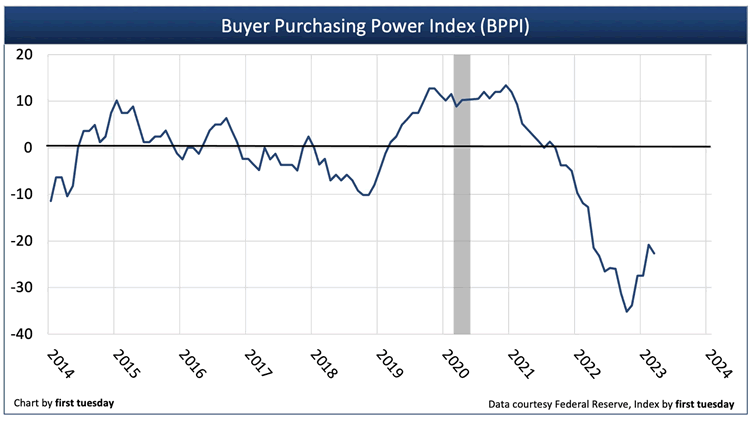
|
Buyer Purchasing Power Index Ends 2022 31% Below a Year Earlier Posted by Carrie B. Reyes
The California Buyer Purchasing Power Index (BPPI) figure remains deeply negative, at -31.0 in the fourth quarter (Q4) of 2022. This figure tells us a homebuyer with the same income is able to borrow 31% less purchase-assist mortgage money than a year ago when mortgage interest rates were still near historic lows. Q4 2022’s basement level BPPI figure reflects a worsening situation for homebuyers reliant on mortgage financing, as the BPPI was positive during 2019-2021 due to consistently lower mortgage interest rates. While the BPPI rises and falls on a short-term basis, in the coming decade, the annual BPPI figure will generally remain negative due to continually rising interest rates, a turnaround in long-term interest rate movement which began in 2012. The impact to homebuyer mortgage funding has been devastating — and the inevitable shockwave to home prices arrived in the second half of 2022, pushing prices to rapidly implode.
The BPPI foreshadows home price movement Homebuyers qualify for a maximum mortgage amount based on their incomes and shifting interest rates. Thus, any rise in mortgage rates instantly cuts the amount they can borrow, and the price they pay for a home is reduced. At the outset of the pandemic, interest rates descended to historic lows in 2020 due to efforts to stimulate lending despite job losses and tightening access to credit. 2022’s rapid mortgage rate increases first made their mark on home sales volume, as market momentum built up during the Pandemic Economy has frozen over. Here in California, home prices began to decline on a monthly basis in mid-2022. As of October 2022, average California home prices are still 4%-to-6% higher than one year earlier. But this spread is narrowing rapidly, with reports (which lag two months behind actual events) expected to show a negative turn by 2023. Without the support of consistently falling interest rates, additional stimulus or income boosts, home prices will continue to fall back in 2023-2024. The Fed and the bond market influence mortgage rates On exiting, the funding and setting of fixed rate mortgage (FRM) rates returned to the bond market. This resulted in a jump in mortgage rates to match bond market MBB yields which, unlike Fed funding, are based on the 10-year Treasury Note rate plus a risk premium rate presently set at double historic norms in anticipation of a recessionary rise in mortgage defaults. The result of all the pandemic fiscal and monetary stimulus of 2020-2021 caused consumer inflation to vastly exceed the Fed’s target of 2%. To rein in and tamp down excess consumer inflation, the Fed bumped up their benchmark rate several times in 2022. This directly increased interest rates on adjustable rate mortgages (ARMs). Further, interest rates on long-term debt obligations, such as the 30-year FRM, used to calculate the BPPI, reflect bond market investor perceptions about the level of success the Fed will achieve in their fight to lower consumer inflation. When the Fed is succeeding in its fight to normalize consumer inflation — as began to appear heading into 2023 — bond market investors accept lower yields, and FRM rates taper slightly, as they have. While mortgage rates skyrocketed in the first three quarters of 2022, they were slashing buyer purchasing power. This brought on a cascade of altered behaviors in the marketing of real estate services, which will remain for years to come. However, as the consumer inflation rate trends back toward 2% expect the 10-year T-Note and mortgage rates to edge downward slightly in 2023, causing the BPPI to return toward zero by 2024. Still, the long-term outlook for the BPPI is a decades’ long period of descent as mortgage rates resume their rise with the economic recovery, likely to gain strength around 2025. Thus, sellers can expect continued downward pressure on home prices. The housing market will see declining sales volume and prices in 2023-2024, with prices bottoming around 2025. Watch for a return of real estate speculators in 2025 to stop the price decline and provide a “dead cat” bounce during the coming slump, with a sustainable recovery taking off with the return of end user homebuyers around 2026-2027. About the BPPI A positive index number means buyers can borrow more money this year than one year earlier. A negative index figure translates to a reduced amount of mortgage funds available. An index of zero means there was no year-over-year change in the amount a buyer can borrow with the same income. At a BPPI of zero, homebuyers cannot purchase at higher prices than one year before unless they resort to adjustable rate mortgages (ARMs) to extend their borrowing reach or greater down payment amounts. As long-term BPPI trend declines, the capacity of buyers to borrow purchase-assist funds is reduced. In turn, buyers needing purchase-assist financing on average can only pay a lesser price for a home. To keep the inventory of homes for sale moving at the same pace, sellers will need to lower prices to accommodate buyer purchasing power or pull their properties off the market.
first tuesday journal online is a real estate news source. It provides analyses and forecasts for the California real estate market, and has done so since 1978.
|
| © 2006 - 2022. All Rights Reserved. |
